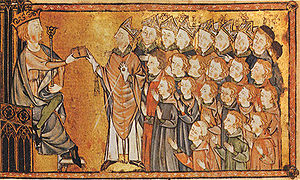Louis X. (France)
Louis X. the quarrel , French Louis X le Hutin ; (* October 4, 1289 in Paris ; † June 5, 1316 in Vincennes Castle ) was King of Navarre from 1305 to 1314 and King of France from 1314 to 1316 .
Life
Louis X. was the eldest son of Philip IV of France and his wife Joan of Navarre .
In 1305 he became king of Navarre and in 1314 of France. From 1305 to 1314 he was also Count of Champagne . As his father's military leader in 1314, he is said to have vigorously pushed for a continuation of the war against Flanders , which earned him his nickname.
Ludwig X found himself in a difficult situation when he took over as the high taxes his father had demanded shortly before his death triggered general opposition. In individual provinces, such as Vermandois, Picardy , Normandy , Champagne , Burgundy and also in the south, the nobles formed "leagues" in order to assert their interests. They demanded the abolition of the general tax (taille), an end to the deterioration of coins and the interference of the royal judges in the judicial rights of the barons as well as the recognition of the right of feuds of the nobility. However, the leagues did not succeed in restricting the position of the kingship decisively, even though Louis X made certain concessions to the individual aristocratic groups in a series of documents in the course of 1315.
The king died surprisingly on June 5, 1316 in Vincennes Castle of a fever. Allegedly after a ball game he went into the cool cellar of the castle to drink a large amount of wine.
He was buried in the tomb of the French kings, today's Saint-Denis cathedral. When the royal tombs of Saint-Denis were sacked during the French Revolution , his tomb was opened and looted on October 18, 1793, and his remains were buried in a mass grave outside the church.
ancestors
| Louis IX Kg. Of France (1214-1270) | |||||||||||||
| Philip III , King of France (1245–1285) | |||||||||||||
| Margaret of Provence (1221–1295) | |||||||||||||
| Philip IV King of France (1268-1314), | |||||||||||||
| James I of Aragon (1208–1276) | |||||||||||||
| Isabella of Aragón (around 1243–1271) | |||||||||||||
| Yolanda of Hungary (1219–1251) | |||||||||||||
| Louis X. King of France | |||||||||||||
| Theobald I of Navarre (1201–1253) | |||||||||||||
| Henry I of Navarre (around 1244–1274) | |||||||||||||
| Margaret of Bourbon-Dampierre (died 1256) | |||||||||||||
| Joan I of Navarre (1273–1305) | |||||||||||||
| Robert I of Artois (1216-1250) | |||||||||||||
| Blanche d'Artois (1248–1302) | |||||||||||||
| Mathilde of Brabant (1224-1288) | |||||||||||||
Descendants
Ludwig X. was the father of an illegitimate daughter:
- Eudeline (* 1305; † after 1330), named after her mother, the king's laundry maid, 1330 abbess in the Poor Clare monastery Couvent des Cordelières in the Faubourg Saint-Marcel in Paris
On September 23, 1305 he married Margaret of Burgundy , who gave birth to a daughter:
- Johanna (born January 28, 1311). As Joan II, she succeeded him as Queen of Navarre.
In his second marriage, he married Clementine of Hungary on August 19, 1315 . She gave birth to a son, but only after his death:
- Johann I (born November 15, 1316). John I succeeded him as King of France for four days before he too died.
heritage
Louis X's death left a problematic succession situation. He left only a daughter and a pregnant wife. His younger brother Philipp "the Tall One" then declared himself ruler of the country until the child was born. In fact, this was a boy who, as King John I , lived only four days (November 15-19, 1316). For the first time in its history, the Capetian dynasty was faced with the lack of male descendants of a king. Now the daughter Johanna moved into the position of a potential successor, but her uncle Philip "the Tall One" was supposed to question her legitimacy because of her parents' close relatives and was crowned King Philip V on January 9, 1317 . In order to deprive Johanna of any further possibilities on the French throne, the new king immediately had the Lex Salica recognized as the sole right of succession for the French crown, which excluded women from the line of succession and was of great importance for the further history of France in the late Middle Ages (see : Hundred Years War ).
Web links
| predecessor | Office | successor |
|---|---|---|
| Philip IV the Handsome |
King of France 1314-1316 |
Johann I. |
| Johanna I. |
King of Navarre 1305-1316 |
Johann I. |
| Johanna I. |
Count of Champagne 1305-1314 |
French crown domain |
| personal data | |
|---|---|
| SURNAME | Louis X. |
| ALTERNATIVE NAMES | Ludwig the brawler |
| BRIEF DESCRIPTION | King of France (1314-1316) |
| DATE OF BIRTH | October 4, 1289 |
| PLACE OF BIRTH | Paris |
| DATE OF DEATH | June 5, 1316 |
| Place of death | Vincennes Castle |


